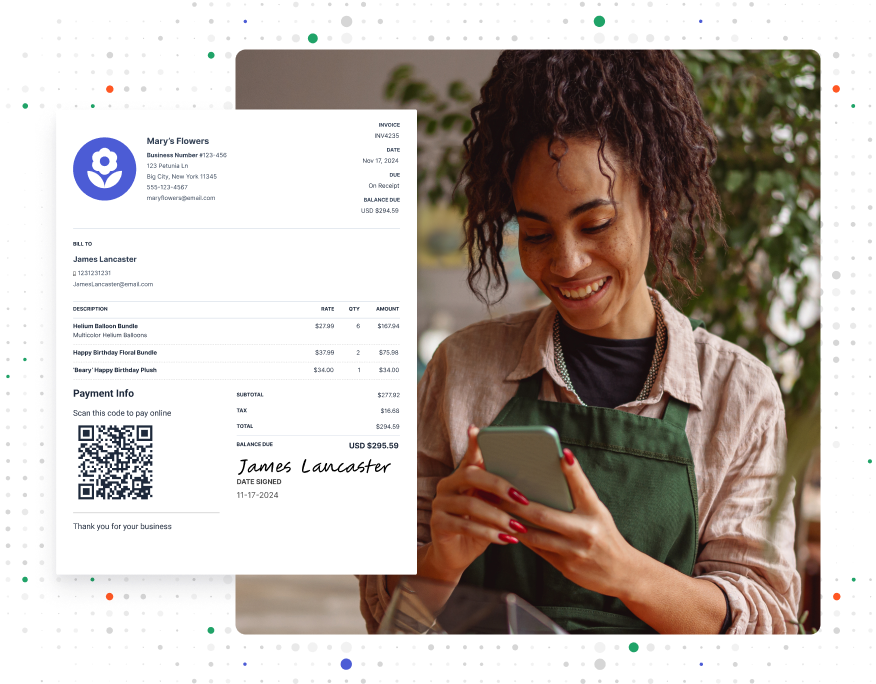What Is a Statement of Accounts? A Helpful Guide

Have you ever wished for an easy way to manage all client transactions in one place? If so, a statement of accounts (SOA) might be the solution you’re looking for.
An SOA is a document that shows all the financial transactions between your business and a client. It helps you see which invoices have been paid and what’s still due. We’ll explain how using SOAs can simplify your finances, improve cash flow, and strengthen client relationships.
What Is a Statement of Accounts?
Think of an SOA as a detailed bank statement. Just as a bank statement shows all deposits and withdrawals, an SOA shows all the transactions between a business and a customer. It helps both the customer and business track payments made and amounts owed.
An SOA is different from an invoice. An invoice is the bill for a single transaction. An SOA details all financial transactions between a business and a client over a specified period of time.
What’s the Purpose of a Statement of Account?

An SOA aims to document the full transaction history between a business and its customer. It shows the following information:
- Purchases
- Payments made
- Remaining balance owed
Additionally, an SOA may show the dates of transactions, reference numbers, and any credits or adjustments applied. This detailed overview minimizes errors and removes any uncertainty about financial transactions.
RELATED ARTICLE — Chart of Accounts: Sample, Definition, and Guide
Uses of Statements of Accounts
SOAs are valuable tools for both businesses and customers. Here’s what they are typically used for:
- Financial Planning. Statements offer valuable insights into financial health and spending patterns. This, in turn, allows for better financial planning and decision-making.
- Checking for Accuracy. These statements allow clients to spot any double payments or mistakes. This prevents overpayments and ensures their financial records are right.
- Payment Reminders. Sellers use statements to remind customers about unpaid balances. They make customers aware of their outstanding debts.
- Budgeting. An SOA shows spending patterns and helps predict future expenses. You can use this for budgeting and financial planning.
- Improving Cash Flow. Timely client payments increase cash flow for businesses. Improved cash flow gives the owner the resources needed to keep the business running like clockwork.
- Avoiding Late Fees. Clients can avoid late fees by staying up-to-date on missed payments.
When To Issue a Statement of Accounts

SOAs are issued for several reasons, each serving a specific purpose. Here’s a list of common instances when businesses might issue SOAs:
- Credit Purchases. Businesses provide regular statements to show the overdue balances on credit purchases.
- Upon Request. When a customer requests it, an SOA provides a detailed view of transactions and balances.
- Reminder of Outstanding Balances. A statement of accounts reminds customers to pay overdue balances. This helps prompt timely payments, improving cash flow.
- Internal Monitoring. Businesses use SOAs internally to track customer activity and financial status. These statements may not even be sent to customers.
FROM ONE OF OUR PARTNERS — Better Bookkeeping for Home Services Companies
Statement of Account Examples
Understanding the different types of account statements can help you track your financial health. Here are some SOA examples, each serving a specific purpose in financial management:
- Cash Flow Statement. A cash flow statement shows the money coming in and going out over a period of time. It helps you understand how well you’re managing cash.
- Balance Sheet. A balance sheet shows a company’s financial position at a specific time. It lists what the company owns (assets), owes (liabilities), and its value (equity).
- Income Statement. An income statement shows the company’s money earned (revenues) and money spent (expenses) over a period. It shows profit or loss.
- Monthly SOA. A monthly statement summarizes all financial transactions between a business and a customer within a month. It helps both parties track sales, payments, and outstanding balances.
RELATED ARTICLE — Credit Memos: What They Are and How To Write One
5 Tips for Issuing a Statement of Accounts

Creating an SOA needs careful work. Here are five tips to help you create and distribute effective statements:
1. Collect All Important Financial Information
Collect all relevant financial data, including:
- Sales invoices
- Receipts
- Bank statements
- Financial reports
- Credit memos
You can also use software tools to scan and automate the entry of transaction details to reduce manual errors.
2. Classify and Organize the Data
Sort and file data into revenue, expenses, assets, and liabilities categories. The use of accounting software can help categorize financial data. This ensures nothing is lost or misreported. Staying organized will make it easier to track and analyze financial performance.
3. Create an Initial Draft of Financial Statements
Prepare financial statements, including income, balance, and cash flow statements. List all transactions with corresponding dates and monthly amounts, including sales, payments, and refunds. Include reference numbers for easy tracking and verification.
4. Review and Reconcile the Data
Review every entry for accuracy. Reconcile the data with bank statements and other external documents to ensure all transactions are accounted for. Double-check calculations for gross profit, recorded income, and debts to ensure all numbers match.
5. Complete and Prepare the Report
Finalize the statements for reporting. Make sure they comply with relevant standards and regulations. Consider getting the statements reviewed by accountants or financial professionals for accuracy. Prepare the report in a clear and organized format, making it easy for clients to understand.
RELATED ARTICLE — Tips for Keeping Track of Invoices And Payments
Manage Your Finances With Invoice Simple
With Invoice Simple, you can track your invoices with ease and maintain organized records. This allows you to issue clear and accurate SOAs to your customers.
You can also issue estimates, keep detailed records, and monitor your monthly income with our easy-to-use reporting features. Get organized today.
Start Your First
Invoice Today
Create customized and professional
invoices and connect with clients
